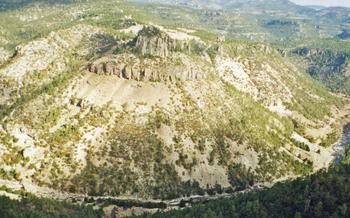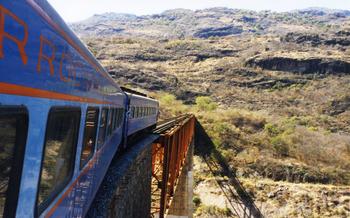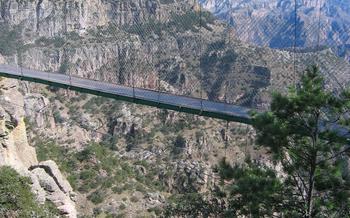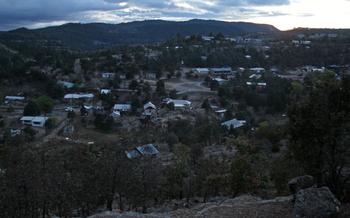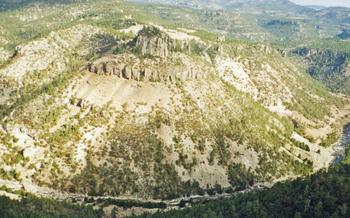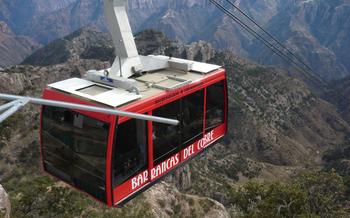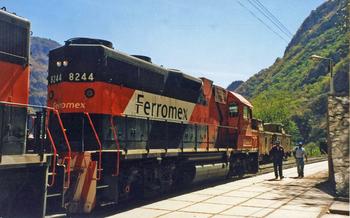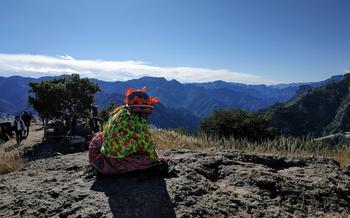
Cave of the Bat
- Copper Canyon Overview
- Things to do in Copper Canyon
- The Cave of the Bat
- When to Visit the Cave of the Bat
- How to Get to the Cave of the Bat
- What to Expect at the Cave of the Bat
- Witnessing the Bat Flight
- Capture the Moment
- Learn About the Bats
- Additional Activities Near the Cave
- Local Cuisine and Dining
- Shopping for Souvenirs
- Accommodations near the Cave
- Cultural Immersion
- Insider Tip: Unveiling Hidden Gems and Local Customs
Copper Canyon Overview
Copper Canyon, a breathtaking natural wonder located in the southwestern part of Chihuahua, Mexico, is a system of canyons that rivals the grandeur of the Grand Canyon in the United States. Formed over millions of years by the relentless erosive forces of the Urique and Batopilas rivers, Copper Canyon boasts a series of six canyons, each boasting unique landscapes, diverse ecosystems, and a rich cultural heritage.
The region's history is deeply intertwined with the indigenous cultures that have inhabited the area for centuries. The Tarahumara, also known as the Rarámuri, are the most prominent indigenous group in the region and have played a pivotal role in shaping the cultural landscape of Copper Canyon. Their traditions, customs, and intimate knowledge of the land continue to influence the way of life in the region.
Things to do in Copper Canyon
The Copper Canyon, often compared to the Grand Canyon in the United States, offers a diverse range of activities for visitors to enjoy. From scenic train rides and thrilling zip lines to mountain biking and hiking, there's something for everyone in this breathtaking natural wonder.
Popular Activities in Copper Canyon:
-
El Chepe Train Ride: Embark on a memorable journey aboard El Chepe, a scenic train that traverses the Copper Canyon. The 653-kilometer (406-mile) route passes through 86 tunnels and 37 bridges, offering stunning views of the canyons, rivers, and forests.
-
Zip-lining: Experience the thrill of soaring through the canyons on a zip line. Several zip-line courses are available, ranging from beginner to advanced levels, providing an adrenaline-pumping adventure with breathtaking views.
-
Mountain Biking: Explore the rugged terrain of the Copper Canyon on a mountain bike. With trails for all skill levels, from easy paths to challenging climbs, mountain biking offers a unique way to immerse yourself in the natural beauty of the canyons.
-
Hiking: Lace up your hiking boots and embark on a journey through the diverse landscapes of the Copper Canyon. From leisurely walks along riverbanks to strenuous hikes to remote viewpoints, there are trails to suit every hiker's abilities and interests.
The Cave of the Bat
Nestled within the heart of Copper Canyon, the Cave of the Bat (Cueva de las Guaguas) stands as a natural wonder of awe-inspiring proportions. This vast cavern, with its cathedral-like dimensions, serves as a sanctuary for millions of bats, making it one of the most significant bat colonies in the world.
Geologically, the Cave of the Bat is a limestone cave, formed over millions of years by the erosive power of water seeping through the rock. Its grand entrance, framed by towering cliffs, leads to a series of interconnected chambers adorned with intricate stalactites and stalagmites.
Beyond its natural beauty, the Cave of the Bat holds deep historical and cultural significance. For centuries, it has been revered by indigenous communities as a sacred site, a place of spiritual connection and reverence for the natural world. Ancient cave paintings and petroglyphs, etched into the cave walls, offer glimpses into the rich cultural heritage of the region.
When to Visit the Cave of the Bat
The best time to visit the Cave of the Bat and witness the incredible spectacle of millions of bats emerging from the cave is during the summer months, especially from June to August. During this period, the weather is generally warm and dry, providing ideal conditions for the bats to emerge en masse.
Although the bats can be seen year-round, the dry season offers the best viewing opportunities as the bats are more active and the surrounding landscape is less obstructed by vegetation. Additionally, the summer months coincide with the peak breeding season, making it an ideal time to observe the bats' fascinating reproductive behavior.
It's important to note that the weather in the Copper Canyon region can be unpredictable, with occasional heavy rains during the summer months. Therefore, it's advisable to check the weather forecast before planning your visit to ensure optimal viewing conditions.
During your visit, you may also have the chance to experience special events and festivals held in the region. These events often showcase the rich cultural heritage of the area and provide a unique opportunity to immerse yourself in the local traditions and customs.
How to Get to the Cave of the Bat
Reaching the Cave of the Bat requires planning and consideration of various transportation options. Several major cities offer convenient access to the cave.
From Chihuahua City, the capital of the state, you can embark on a scenic train journey aboard the renowned Chihuahua al Pacífico train, known as El Chepe. This iconic train winds through the breathtaking landscapes of the Copper Canyon, offering a unique and unforgettable travel experience.
Alternatively, Los Mochis, located in the state of Sinaloa, serves as another gateway to the cave. From here, you can take the El Fuerte-Los Mochis train, which traverses the canyon's eastern rim and provides stunning views along the way.
For those seeking a more personalized and flexible experience, self-driving to the cave is an excellent option. Rental cars are available in major cities, allowing you to explore the region at your own pace and uncover hidden gems along the way.
To fully immerse yourself in the local culture and history, guided tours are highly recommended. Professional tour operators offer a range of itineraries that include transportation, knowledgeable guides, and insightful commentary, ensuring a comprehensive and enriching visit to the Cave of the Bat.
What to Expect at the Cave of the Bat
When you arrive at the Cave of the Bat, you'll find a visitor center that offers a wealth of information about the cave and its inhabitants. There are educational exhibits, displays, and opportunities to interact with experts who can answer your questions about bats and their behavior. The center also provides guided tours of the cave, which are highly recommended if you want to learn more about the cave's history, geology, and cultural significance.
If you prefer to explore the cave on your own, you can do so by following the well-marked trails that lead through the cave. However, it's important to be aware of the safety measures and guidelines that are in place to protect the bats and their habitat. These guidelines include staying on the designated trails, not using flash photography, and being respectful of the bats' natural behavior.
Witnessing the Bat Flight
A spectacle of nature, unlike anything you've ever seen, awaits you at the Cave of the Bat. As dusk settles and darkness engulfs the canyon, millions of bats emerge from the cave, creating a mesmerizing aerial ballet. The sky transforms into a living canvas, a symphony of fluttering wings and swirling silhouettes against the backdrop of the setting sun.
The bats, primarily Mexican free-tailed bats, are an integral part of the region's ecosystem, acting as natural pest controllers and pollinators. Their nightly exodus is a testament to their ecological importance. The sheer volume of bats is awe-inspiring, a sight that leaves visitors breathless.
As the bats emerge, they fill the air with a cacophony of squeaks and chirps, creating an eerie yet captivating soundscape. The synchronized flight patterns, the swirling masses, and the sheer scale of the event are a testament to the wonders of nature.
Watching the bats emerge from the cave is an experience that will stay with you long after you leave Copper Canyon. It's a reminder of the beauty and fragility of our natural world and the importance of protecting these incredible creatures.
Capture the Moment
Photographing the bats at the Cave of the Bat is an experience that will leave you with unforgettable memories. To capture the incredible spectacle, consider the following tips:
-
Use a sturdy tripod: The low-light conditions inside the cave require a stable platform for your camera to avoid blurry images.
-
Experiment with shutter speeds: Depending on the desired effect, adjust the shutter speed to capture the bats in flight or as streaks of light.
-
Choose the right lens: A wide-angle lens allows you to capture the vastness of the cave and the sheer number of bats, while a telephoto lens can bring you closer to the action.
-
Consider using a flash: A flash can help illuminate the bats and reduce noise in your images, but be sure to use it sparingly to avoid disturbing the bats.
-
Respect the bats' habitat: Always follow the guidelines provided by the park rangers and avoid using bright lights or making loud noises that could disrupt the bats.
Learn About the Bats
The Cave of the Bat is not just about watching the bats emerge; it's also about learning about these fascinating creatures and their vital role in the ecosystem. The visitor center features educational exhibits and displays that provide in-depth information about the various bat species that call the cave home. Interactive exhibits allow visitors to engage with the material, and knowledgeable guides are available to answer questions and share their expertise.
Learn about the bats' unique adaptations, their migration patterns, and their importance as pollinators and seed dispersers. Discover the local legends and folklore surrounding these mysterious creatures, and gain a deeper appreciation for the incredible biodiversity that the Copper Canyon region harbors.
Additional Activities Near the Cave
The Copper Canyon region offers a wealth of additional attractions and activities beyond the Cave of the Bat. For those who enjoy hiking and nature, there are numerous trails and viewpoints that provide breathtaking panoramas of the canyons and surrounding landscapes. The Urique Canyon, in particular, offers a challenging yet rewarding hike known as the "Camino Real" or Royal Road, which takes you through stunning scenery and traditional Tarahumara villages.
Nearby towns and villages such as Batopilas, Urique, and Creel are worth exploring for their rich cultural heritage, colonial architecture, and vibrant markets. In these towns, you can immerse yourself in the local way of life, sample delicious regional cuisine, and purchase unique handicrafts and souvenirs made by skilled artisans.
For a truly authentic experience, consider participating in one of the many traditional festivals and events held throughout the year in the Copper Canyon region. These festivals often showcase indigenous cultures and customs, featuring colorful parades, music, dance, and traditional Tarahumara games.
Local Cuisine and Dining
A culinary adventure awaits you in the Copper Canyon region, where traditional Mexican cuisine blends with local flavors and ingredients. Try the mouthwatering regional dishes such as enchiladas mineras (corn tortillas filled with cheese, potatoes, and a spicy sauce), or pollo en salsa verde (chicken in a tomatillo sauce). For a taste of local delicacies, indulge in chapulines (fried grasshoppers) or escamoles (ant eggs), considered delicacies in Mexican cuisine.
The best way to savor the authentic flavors of the region is to visit the local markets and restaurants. In the town of Creel, the Mercado de Artesanías offers a vibrant array of fresh produce, spices, and handmade tortillas. For a memorable dining experience, try the renowned La Casa de las Sirenas, known for its traditional Mexican dishes prepared with local ingredients.
For those with dietary restrictions, vegetarian options are widely available, such as nopales con queso (cactus paddles with cheese) or frijoles borrachos (drunken beans). Most restaurants can accommodate special requests and provide alternatives for those with specific dietary needs.
Shopping for Souvenirs
Your visit to the Copper Canyon is an excellent opportunity to take home unique and meaningful souvenirs. Browse through local markets and artisan shops to find a treasure trove of handcrafted items, including intricate pottery, colorful textiles, and traditional jewelry. Support the local economy by purchasing directly from the artisans, who pour their heart and soul into creating these beautiful works of art. Don't forget to engage in friendly bargaining, a cultural practice that is both expected and respected in Mexico. Remember to be respectful and mindful when negotiating prices, as these artisans often rely on their craft as their primary source of income. Your purchases not only serve as cherished mementos of your journey but also contribute to the preservation of traditional skills and livelihoods in the region.
Accommodations near the Cave
A range of accommodation options is available near the Cave of the Bat, catering to different budgets and preferences. For a luxurious stay, consider the five-star Hacienda Barrancas del Cobre, offering stunning canyon views and world-class amenities. Mid-range hotels like Hotel Divisadero and Hotel Mansion Tarahumara provide comfortable rooms and convenient locations. Budget travelers can opt for hostels like Chepe Express Hostel or Casa de la Abuela, offering dormitory-style rooms and a social atmosphere.
To immerse yourself in the local culture, consider staying in a traditional Tarahumara village. Homestays and guesthouses offer a unique opportunity to interact with the indigenous community and experience their way of life. Remember to book your accommodation in advance, especially during peak season, to avoid disappointment.
Cultural Immersion
Visiting the Cave of the Bat is not just about witnessing a natural spectacle; it's also an opportunity for cultural immersion. The Copper Canyon region is home to several indigenous communities, each with its unique traditions, customs, and languages. Engaging with these communities allows visitors to gain a deeper understanding of Mexico's rich cultural heritage. One can visit local markets, witness traditional dances, and participate in festivals that celebrate indigenous culture. Interacting with the locals, learning about their way of life, and supporting their traditional crafts and businesses creates a meaningful and enriching travel experience. Respecting local customs and traditions is essential to ensure a positive and mutually beneficial interaction.
Insider Tip: Unveiling Hidden Gems and Local Customs
To truly immerse yourself in the magic of Copper Canyon and the Cave of the Bat, venture beyond the main tourist routes and discover hidden gems that only locals know about. Seek out secret viewpoints where you can witness the mesmerizing bat flight from a unique perspective, away from the crowds. Explore off-the-beaten-path attractions such as secluded waterfalls, ancient ruins, and charming villages nestled in the heart of the canyon.
Respect local customs and traditions to ensure a harmonious and enriching experience. Learn about the indigenous cultures that call Copper Canyon home, their beliefs, and their way of life. Engage with local communities, participate in traditional festivals and events, and support local artisans by purchasing their beautiful handicrafts. Embrace the warmth and hospitality of the local people, and let their stories and experiences enrich your journey.

